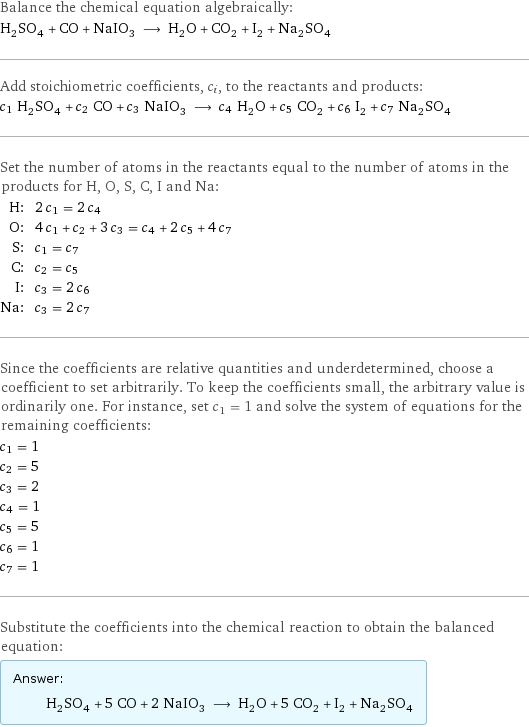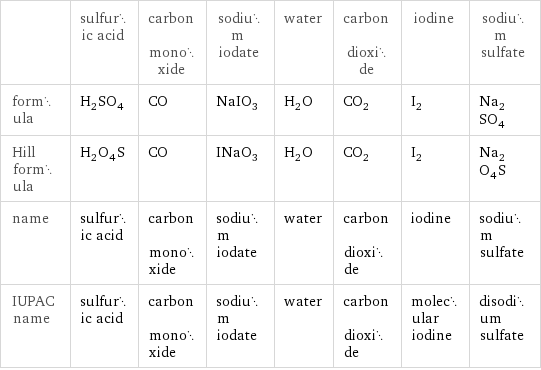Input interpretation

H_2SO_4 sulfuric acid + CO carbon monoxide + NaIO_3 sodium iodate ⟶ H_2O water + CO_2 carbon dioxide + I_2 iodine + Na_2SO_4 sodium sulfate
Balanced equation

Balance the chemical equation algebraically: H_2SO_4 + CO + NaIO_3 ⟶ H_2O + CO_2 + I_2 + Na_2SO_4 Add stoichiometric coefficients, c_i, to the reactants and products: c_1 H_2SO_4 + c_2 CO + c_3 NaIO_3 ⟶ c_4 H_2O + c_5 CO_2 + c_6 I_2 + c_7 Na_2SO_4 Set the number of atoms in the reactants equal to the number of atoms in the products for H, O, S, C, I and Na: H: | 2 c_1 = 2 c_4 O: | 4 c_1 + c_2 + 3 c_3 = c_4 + 2 c_5 + 4 c_7 S: | c_1 = c_7 C: | c_2 = c_5 I: | c_3 = 2 c_6 Na: | c_3 = 2 c_7 Since the coefficients are relative quantities and underdetermined, choose a coefficient to set arbitrarily. To keep the coefficients small, the arbitrary value is ordinarily one. For instance, set c_1 = 1 and solve the system of equations for the remaining coefficients: c_1 = 1 c_2 = 5 c_3 = 2 c_4 = 1 c_5 = 5 c_6 = 1 c_7 = 1 Substitute the coefficients into the chemical reaction to obtain the balanced equation: Answer: | | H_2SO_4 + 5 CO + 2 NaIO_3 ⟶ H_2O + 5 CO_2 + I_2 + Na_2SO_4
Structures

+ + ⟶ + + +
Names

sulfuric acid + carbon monoxide + sodium iodate ⟶ water + carbon dioxide + iodine + sodium sulfate
Reaction thermodynamics
Enthalpy

| sulfuric acid | carbon monoxide | sodium iodate | water | carbon dioxide | iodine | sodium sulfate molecular enthalpy | -814 kJ/mol | -110.5 kJ/mol | -481.8 kJ/mol | -285.8 kJ/mol | -393.5 kJ/mol | 0 kJ/mol | -1387 kJ/mol total enthalpy | -814 kJ/mol | -552.5 kJ/mol | -963.6 kJ/mol | -285.8 kJ/mol | -1968 kJ/mol | 0 kJ/mol | -1387 kJ/mol | H_initial = -2330 kJ/mol | | | H_final = -3640 kJ/mol | | | ΔH_rxn^0 | -3640 kJ/mol - -2330 kJ/mol = -1310 kJ/mol (exothermic) | | | | | |
Equilibrium constant
![Construct the equilibrium constant, K, expression for: H_2SO_4 + CO + NaIO_3 ⟶ H_2O + CO_2 + I_2 + Na_2SO_4 Plan: • Balance the chemical equation. • Determine the stoichiometric numbers. • Assemble the activity expression for each chemical species. • Use the activity expressions to build the equilibrium constant expression. Write the balanced chemical equation: H_2SO_4 + 5 CO + 2 NaIO_3 ⟶ H_2O + 5 CO_2 + I_2 + Na_2SO_4 Assign stoichiometric numbers, ν_i, using the stoichiometric coefficients, c_i, from the balanced chemical equation in the following manner: ν_i = -c_i for reactants and ν_i = c_i for products: chemical species | c_i | ν_i H_2SO_4 | 1 | -1 CO | 5 | -5 NaIO_3 | 2 | -2 H_2O | 1 | 1 CO_2 | 5 | 5 I_2 | 1 | 1 Na_2SO_4 | 1 | 1 Assemble the activity expressions accounting for the state of matter and ν_i: chemical species | c_i | ν_i | activity expression H_2SO_4 | 1 | -1 | ([H2SO4])^(-1) CO | 5 | -5 | ([CO])^(-5) NaIO_3 | 2 | -2 | ([NaIO3])^(-2) H_2O | 1 | 1 | [H2O] CO_2 | 5 | 5 | ([CO2])^5 I_2 | 1 | 1 | [I2] Na_2SO_4 | 1 | 1 | [Na2SO4] The equilibrium constant symbol in the concentration basis is: K_c Mulitply the activity expressions to arrive at the K_c expression: Answer: | | K_c = ([H2SO4])^(-1) ([CO])^(-5) ([NaIO3])^(-2) [H2O] ([CO2])^5 [I2] [Na2SO4] = ([H2O] ([CO2])^5 [I2] [Na2SO4])/([H2SO4] ([CO])^5 ([NaIO3])^2)](../image_source/dffc8dadfd87d4226657889f2b70ea29.png)
Construct the equilibrium constant, K, expression for: H_2SO_4 + CO + NaIO_3 ⟶ H_2O + CO_2 + I_2 + Na_2SO_4 Plan: • Balance the chemical equation. • Determine the stoichiometric numbers. • Assemble the activity expression for each chemical species. • Use the activity expressions to build the equilibrium constant expression. Write the balanced chemical equation: H_2SO_4 + 5 CO + 2 NaIO_3 ⟶ H_2O + 5 CO_2 + I_2 + Na_2SO_4 Assign stoichiometric numbers, ν_i, using the stoichiometric coefficients, c_i, from the balanced chemical equation in the following manner: ν_i = -c_i for reactants and ν_i = c_i for products: chemical species | c_i | ν_i H_2SO_4 | 1 | -1 CO | 5 | -5 NaIO_3 | 2 | -2 H_2O | 1 | 1 CO_2 | 5 | 5 I_2 | 1 | 1 Na_2SO_4 | 1 | 1 Assemble the activity expressions accounting for the state of matter and ν_i: chemical species | c_i | ν_i | activity expression H_2SO_4 | 1 | -1 | ([H2SO4])^(-1) CO | 5 | -5 | ([CO])^(-5) NaIO_3 | 2 | -2 | ([NaIO3])^(-2) H_2O | 1 | 1 | [H2O] CO_2 | 5 | 5 | ([CO2])^5 I_2 | 1 | 1 | [I2] Na_2SO_4 | 1 | 1 | [Na2SO4] The equilibrium constant symbol in the concentration basis is: K_c Mulitply the activity expressions to arrive at the K_c expression: Answer: | | K_c = ([H2SO4])^(-1) ([CO])^(-5) ([NaIO3])^(-2) [H2O] ([CO2])^5 [I2] [Na2SO4] = ([H2O] ([CO2])^5 [I2] [Na2SO4])/([H2SO4] ([CO])^5 ([NaIO3])^2)
Rate of reaction
![Construct the rate of reaction expression for: H_2SO_4 + CO + NaIO_3 ⟶ H_2O + CO_2 + I_2 + Na_2SO_4 Plan: • Balance the chemical equation. • Determine the stoichiometric numbers. • Assemble the rate term for each chemical species. • Write the rate of reaction expression. Write the balanced chemical equation: H_2SO_4 + 5 CO + 2 NaIO_3 ⟶ H_2O + 5 CO_2 + I_2 + Na_2SO_4 Assign stoichiometric numbers, ν_i, using the stoichiometric coefficients, c_i, from the balanced chemical equation in the following manner: ν_i = -c_i for reactants and ν_i = c_i for products: chemical species | c_i | ν_i H_2SO_4 | 1 | -1 CO | 5 | -5 NaIO_3 | 2 | -2 H_2O | 1 | 1 CO_2 | 5 | 5 I_2 | 1 | 1 Na_2SO_4 | 1 | 1 The rate term for each chemical species, B_i, is 1/ν_i(Δ[B_i])/(Δt) where [B_i] is the amount concentration and t is time: chemical species | c_i | ν_i | rate term H_2SO_4 | 1 | -1 | -(Δ[H2SO4])/(Δt) CO | 5 | -5 | -1/5 (Δ[CO])/(Δt) NaIO_3 | 2 | -2 | -1/2 (Δ[NaIO3])/(Δt) H_2O | 1 | 1 | (Δ[H2O])/(Δt) CO_2 | 5 | 5 | 1/5 (Δ[CO2])/(Δt) I_2 | 1 | 1 | (Δ[I2])/(Δt) Na_2SO_4 | 1 | 1 | (Δ[Na2SO4])/(Δt) (for infinitesimal rate of change, replace Δ with d) Set the rate terms equal to each other to arrive at the rate expression: Answer: | | rate = -(Δ[H2SO4])/(Δt) = -1/5 (Δ[CO])/(Δt) = -1/2 (Δ[NaIO3])/(Δt) = (Δ[H2O])/(Δt) = 1/5 (Δ[CO2])/(Δt) = (Δ[I2])/(Δt) = (Δ[Na2SO4])/(Δt) (assuming constant volume and no accumulation of intermediates or side products)](../image_source/e44a158b67bbf1e70a6f0846e2707980.png)
Construct the rate of reaction expression for: H_2SO_4 + CO + NaIO_3 ⟶ H_2O + CO_2 + I_2 + Na_2SO_4 Plan: • Balance the chemical equation. • Determine the stoichiometric numbers. • Assemble the rate term for each chemical species. • Write the rate of reaction expression. Write the balanced chemical equation: H_2SO_4 + 5 CO + 2 NaIO_3 ⟶ H_2O + 5 CO_2 + I_2 + Na_2SO_4 Assign stoichiometric numbers, ν_i, using the stoichiometric coefficients, c_i, from the balanced chemical equation in the following manner: ν_i = -c_i for reactants and ν_i = c_i for products: chemical species | c_i | ν_i H_2SO_4 | 1 | -1 CO | 5 | -5 NaIO_3 | 2 | -2 H_2O | 1 | 1 CO_2 | 5 | 5 I_2 | 1 | 1 Na_2SO_4 | 1 | 1 The rate term for each chemical species, B_i, is 1/ν_i(Δ[B_i])/(Δt) where [B_i] is the amount concentration and t is time: chemical species | c_i | ν_i | rate term H_2SO_4 | 1 | -1 | -(Δ[H2SO4])/(Δt) CO | 5 | -5 | -1/5 (Δ[CO])/(Δt) NaIO_3 | 2 | -2 | -1/2 (Δ[NaIO3])/(Δt) H_2O | 1 | 1 | (Δ[H2O])/(Δt) CO_2 | 5 | 5 | 1/5 (Δ[CO2])/(Δt) I_2 | 1 | 1 | (Δ[I2])/(Δt) Na_2SO_4 | 1 | 1 | (Δ[Na2SO4])/(Δt) (for infinitesimal rate of change, replace Δ with d) Set the rate terms equal to each other to arrive at the rate expression: Answer: | | rate = -(Δ[H2SO4])/(Δt) = -1/5 (Δ[CO])/(Δt) = -1/2 (Δ[NaIO3])/(Δt) = (Δ[H2O])/(Δt) = 1/5 (Δ[CO2])/(Δt) = (Δ[I2])/(Δt) = (Δ[Na2SO4])/(Δt) (assuming constant volume and no accumulation of intermediates or side products)
Chemical names and formulas

| sulfuric acid | carbon monoxide | sodium iodate | water | carbon dioxide | iodine | sodium sulfate formula | H_2SO_4 | CO | NaIO_3 | H_2O | CO_2 | I_2 | Na_2SO_4 Hill formula | H_2O_4S | CO | INaO_3 | H_2O | CO_2 | I_2 | Na_2O_4S name | sulfuric acid | carbon monoxide | sodium iodate | water | carbon dioxide | iodine | sodium sulfate IUPAC name | sulfuric acid | carbon monoxide | sodium iodate | water | carbon dioxide | molecular iodine | disodium sulfate